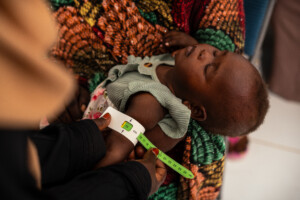Number of ‘watery diarrhoea’ cases in Sudan dropped: OCHA
Following more than a year of intensive efforts by the Sudanese Ministry of Health, the World Health Organization (WHO), the UN Children’s Agency (UNICEF), and other health partners managed to mitigate the outbreak of Acute Watery Diarrhoea (AWD), the number of cases in the country dropped significantly during the past weeks.
Following more than a year of intensive efforts by the Sudanese Ministry of Health, the World Health Organization (WHO), the UN Children’s Agency (UNICEF), and other health partners managed to mitigate the outbreak of Acute Watery Diarrhoea (AWD), the number of cases in the country dropped significantly during the past weeks.
The UN Office for the Coordination of Humanitarian Affairs (OCHA) in Sudan reports in its latest bulletin that to stop the spread of AWD completely, the response must continue until no cases are reported in the country for three consecutive weeks.
Only 78 new cases and two related deaths were reported between 8-14 October, down from a peak of nearly 2,000 new cases at the end of June this year.
Eight states reported active case transmissions and the only state reporting two AWD-related deaths was South Kordofan. The Health Ministry continued to lead an active scale-up of interventions to ensure a final stop to the spread of AWD.
One key measure -which the Health Ministry is considering to end the current outbreak- is a renewed Oral Cholera Vaccine (OCV) campaign. The Ministry, in consultation with WHO and other stakeholders, has decided to explore the need and possibility of introducing OCV in the high-risk states in Sudan, namely White Nile, Kassala, West and South Darfur, and South Kordofan, the OCHA bulletin reads.
 Risk assessments are currently ongoing in these states to determine target areas and groups. Teams are investigating success factors such as accessibility and availability of health services, disease surveillance capacity, water, sanitation and hygiene, capacity to implement mass vaccination campaigns, cold-chain capacity at central and field levels, and monitoring and evaluation.
Risk assessments are currently ongoing in these states to determine target areas and groups. Teams are investigating success factors such as accessibility and availability of health services, disease surveillance capacity, water, sanitation and hygiene, capacity to implement mass vaccination campaigns, cold-chain capacity at central and field levels, and monitoring and evaluation.
The possible OCV campaign, paired with ongoing and intensified activities in WHO's six other key response areas (health capacity building, AWD case management, provision of key medicine and medical supplies, water quality control, vector control, and hygiene promotion), are hoped to stop the AWD outbreak in Sudan.
Cholera
In spite of numerous independent confirmations (conducted according to WHO standards) that the disease which broke out in Blue Nile state in August last year turned out to be cholera, the Government of Sudan and several international organisations still refuse to refer to it by this name.
Since August 2016, the disease spread in eastern Sudan, and later to the Northern State and central Sudan’s El Gezira. In April, sources in White Nile state reported a rapid spread of cholera. The disease then spread to North Kordofan, and fully hit Khartoum in May.
According to the World Health Organization (WHO) and the Sudanese Ministry of Health two weeks ago, the total number of reported cases of AWD across 18 states of Sudan has reached over 35,000 people – including 800 related deaths since the outbreak of the infectious disease in Blue Nile state in August last year.
These casualty numbers conflict with what Sudanese doctors of the National Epidemiological Corporation reported in early July: nearly 24,000 Sudanese have been infected and 940 cholera patients have died.
Follow #CholeraInSudan, #الكوليرا_السودان for ongoing coverage by Radio Dabanga











 and then
and then